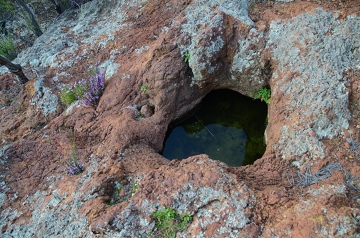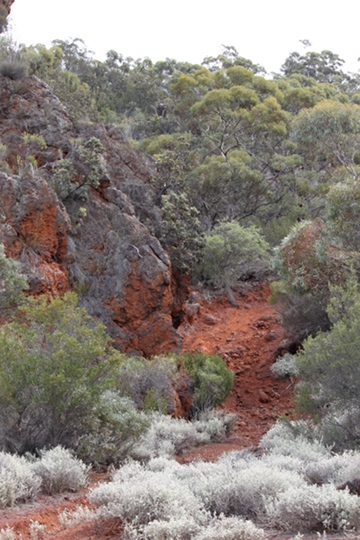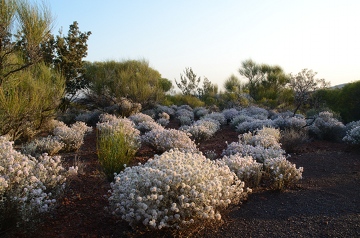Protection of Indigenous Cultural Heritage
If you are looking at this page, then maybe you are interested in Aboriginal Cultural Heritage or simply curious to learn more? The following information is brief, touching on the main aspects of Aboriginal sites and Native Title. Any inaccuracies or omissions are entirely our own. If you would like to know more visit; the Department of Planning, Land and Heritage (DPLH) website (www.dplh.wa.gov.au) to connect to the Aboriginal Affairs website (previously Department of Aboriginal Affairs, DAA and prior to this as Department of Infigenous Affairs, DIA), and the National Native Title Tribunal website (www.nntt.gov.au). They provide a wealth of information. The Aboriginal Cultural Heritage and Natural Heritage are both very significant at Helena and Aurora Range. As an intrinsic part of our Australian Heritage, they have great value to all of us, and are a part of who we are.
Aboriginal Sites
Legislation to protect Aboriginal sacred sites
In Western Australia there is the Aboriginal Heritage Act 1972.
What are Aboriginal Sites?
The Department of Aboriginal Affairs (DAA) describe Aboriginal sites on their website as:
“Aboriginal sites are a precious part of the heritage of the whole community. They are of immense cultural, scientific, educational and historic interest.” and that “Aboriginal heritage sites provide Aboriginal people today with an important link to their culture and past."
Aboriginal Sites are places
In Western Australia, Aboriginal Sites are defined by Section 5 in the Aboriginal Heritage Act 1972 as "any place" where;
- persons of Aboriginal descent have left any object (natural or artificial) for any purpose connected with the traditional cultural life of the Aboriginal people OR
- is a sacred, ritual or ceremonial site OR
- is associated with the Aboriginal people (in the opinion of the Committee) OR
- objects to which the Act applies are traditionally stored or have been taken and removed.
In each case the 'place' needs to be determined to have importance and significance to either the Aboriginal people, as in (a) and (b), or the cultural heritage of the State as in (c). (source; Aboriginal Heritage Act 1972)
Register of Aboriginal Sites in Western Australia
The Department of Aboriginal Affairs (DAA) maintains a Register of Aboriginal Sites in Western Australia. Within the Northern Yilgarn it was determined that at least 75 Aboriginal sites were registered (Issues Paper 2008). There are seven registered Aboriginal Sites on Bungalbin (Helena and Aurora Range) and 11 Aboriginal sites that have been lodged on the Register for Bungalbin, although they have yet to be fully assessed, see Aboriginal sites on Bungalbin and Traditional Owners of Range.
Aboriginal sites are different from Native Title. While the relationship between Aboriginal sites and Native Title do not appear to be addressed in the Aboriginal Heritage Act 1972, section 8 (Availability for traditional use) of the Act indicates that there is no requirement for the users of a site [or therefore recognition of a site] to be limited to those 'from the country' (have Native Title, officially recognised or otherwise), as those with an "interest in the place or object" can use an Aboriginal site where has "traditional and current importance".
Note: The Queenland Aboriginal Cultural Heritage Act 2003 addresses the relationship between Aboriginal sites and Native Title as "Aboriginal cultural heritage can exist on an area regardless of the nature of land tenure. The existance of Aboriginal cultural heritage does not mean that native title exists over the area."
Use of lands where there are Aboriginal sites (registered or unregistered)
Under section 18 of the Aboriginal Heritage Act 1972, landowners can apply for permission from the Minister for Indigenous Affairs to use areas of land where Aboriginal sites and objects are located. The Aboriginal Cultural Material Committee (ACMC) considers the applications under section 18 and recommends to the Minister for Indigenous Affairs whether consent be given to the use of such lands, as requested by the landowner. If the proposal is significant and has been referred to the Minister of the Environment and Environmental Protection Authority then decisions under the Aboriginal Heritage Act 1972 are constrained until the Environmental Protection Act 1986 Part IV assessment has been completed. (source: adapted from DIA website).
Protection of lands with Aboriginal sites
Areas of land can be Protected (section 19) or Temporarily Protected (section 20) or have a Covenant placed over it (section 27) under the Aboriginal Heritage Act 1972.
Some points to be aware of in regard to Aboriginal sites:
- The people who register Aboriginal sites do not have to show that the site is within their country (e.g. the country they are "born to" via their grandparents or great grandparents who were born in the country). In other words, Aboriginal Nations and groups may have Aboriginal sites outside 'their country'.
- It may or may not be fair to say, however, Aboriginal sites appear to have a limitation in that they do not protect the surrounding area that they are situated within.
The registration and protection of Aboriginal sites is important, however, they are not sufficient on their own to provide full protection of Aboriginal Culture.
Native Title
Native title is recognised in Australian law. It is "the recogition in Australian law that some Aboriginal and Torres Strait Islander people continue to hold rights to their lands and waters which come from their traditional laws and customs." (National Native Tribunal, 2009). Native Title is determined by the Federal Court. It can take many years before a claim is resolved. Under the Native Title Act 1993 (Cwlth), the National Native Title Tribunal provides assistance to people; to prepare applications for native title, in any matters relating to native title proceeding, by mediating future act cases and to negotiate stand-alone Indigenous land use agreements (ILUAs). There is currently no Native Title claim that includes Helena and Aurora Range (Bungalbin), see Traditional Owners of Range.
National Native Title Tribunal
The National Native Title Tribunal is an "impartial, independent statutory body" (National Native Title Tribunal website, November 2012). The Tribunal came in to operation in January 1994. It is part of the Attorney-General's portfolio, as is the Federal Court of Australia.
The National Native Title Tribunal maintains three registers. These are:
- The National Native Title Register
- The Register of Native Title Claims
- The Register of Indigenous Land Use Agreements
Legislation under the Native Title Act 1993 (Cwlth) includes:
- Native Title (Indigenous Land Use Agreements) Regulations 1999
(referred to as the ILUA Regulations) - Native Title (Prescribed Body Corporate) Regulations 1999
(referred to as the PBC Regulations)
Future Acts
Any proposed activity or development, within the area of native title, that may affect native title is classified as a 'future act'. The 'future act process' is where native title claimants and project proponents can negotiate their interests during the interim period between the lodgement of a claim for native title and its determination. Native title claimants have the right to stop a 'future act' such as a mining project. However, this is not the case for many other types of 'future acts'. For some 'future acts' there may not even be the option or right to negotiate, although other rights may be available.
Indigenous Land Use Agreements (ILUAs)
Indigenous Land Use Agreements (ILUAs) are a voluntary agreement made between native title holders (including one or more groups) and other parties. It is a binding agreement.
ILUAs provide an efficient way of resolving native title issues. The agreements provide recognition to Indigenous Australians of their native title such that they can benefit where part of their land is being used for development or other purposes. From an Indigenous perspective, agreements can include restricting access to protect Indigenous cultural sites, provision of training or employment for local Indigenous people and consultation with local Indigenous people re planning decisions. The agreements can also involve the consent of a future act or class (group) of future acts, the non-extinguishment of native title rights and interests with the doing of the future act, and in some cases the surrender of native title.
There are three types of ILUAs. They are (1) area agreements (2) body corporate agreements and (3) alternative procedure agreements. Body corporate agreements require that there is a determination of native title and a registered native title body corporate (bodies corporate) for the whole area covered by the agreement. Area agreements do not have these requirements and therefore enable ILUAs to be made where native title claims have yet to be determined. An area agreement "can be about almost anything related to native title rights and interests" ("Area agreements: guidelines for registration" National Native Title Tribunal website viewed November 2012). Alternative procedure agreements must have at least one native title body corporate for part of the area or at least one representative body for the area. If there is a registered native title body corporate for the whole area of the agreement an alternative procedure agreement cannot be used.
ILUAs can be registered with the National Native Tribunal, however, it needs to meet the requirements of the Native Title Act 1993 (Cwlth).
References
- Issue paper (2008) Northern Yilgarn (Mt Manning Range, Mt Elvire and Jaurdi) Conservation Reserves Management Plan.
- Maddock J (1998) The Wheels of Change, A History of the District. Shire of Westonia.
- National Native Title Tribunal (2009) Working with native title - Linking native title and government processes. 3rd Edition, August 2009. [pdf download available from Native Title Tribunal website]



